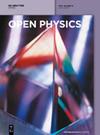Stability analysis and numerical results for some schemes discretising 2D nonconstant coefficient advection–diffusion equations
IF 1.8
4区 物理与天体物理
Q2 PHYSICS, MULTIDISCIPLINARY
引用次数: 0
Abstract
We solve two numerical experiments described by 2D nonconstant coefficient advection–diffusion equations with specified initial and boundary conditions. Three finite difference methods, namely Lax–Wendroff, Du-Fort–Frankel and a nonstandard finite difference scheme, are derived and used to solve the two problems, whereby only the first problem has an exact solution. Stability analysis is performed to obtain a range of values of the time step size at a fixed spatial step size. We obtain the rate of convergence in space when the three methods are used to solve Problem 1. Computational times of the three algorithms are computed for Problem 1. Results are displayed for the two problems using the three methods at times二维非恒定系数平流扩散方程离散化某些方案的稳定性分析和数值结果
我们求解了两个由二维非恒定系数平流扩散方程描述的数值实验,并指定了初始条件和边界条件。推导出三种有限差分方法,即 Lax-Wendroff、Du-Fort-Frankel 和非标准有限差分方案,并用于求解这两个问题,其中只有第一个问题有精确解。我们进行了稳定性分析,以获得在固定空间步长下时间步长的取值范围。当使用这三种方法求解问题 1 时,我们得到了空间收敛速率。针对问题 1 计算了三种算法的计算时间。结果显示了在时间 T=1.0 T=1.0 和 T=5.0 T=5.0 时使用三种方法解决两个问题的结果。主要的新颖之处在于稳定性分析,这并不简单,因为我们使用的是离散二维非定常系数平流扩散方程的数值方法,其中涉及许多参数。第二个亮点是从三种方法中确定最有效的方案。第三,关于分析和使用数值方法求解非定常系数平流-扩散方程的公开研究很少,这篇文章是极少数处理此类主题的文章之一。
本文章由计算机程序翻译,如有差异,请以英文原文为准。
求助全文
约1分钟内获得全文
求助全文
来源期刊

Open Physics
PHYSICS, MULTIDISCIPLINARY-
CiteScore
3.20
自引率
5.30%
发文量
82
审稿时长
18 weeks
期刊介绍:
Open Physics is a peer-reviewed, open access, electronic journal devoted to the publication of fundamental research results in all fields of physics. The journal provides the readers with free, instant, and permanent access to all content worldwide; and the authors with extensive promotion of published articles, long-time preservation, language-correction services, no space constraints and immediate publication. Our standard policy requires each paper to be reviewed by at least two Referees and the peer-review process is single-blind.
 求助内容:
求助内容: 应助结果提醒方式:
应助结果提醒方式:


